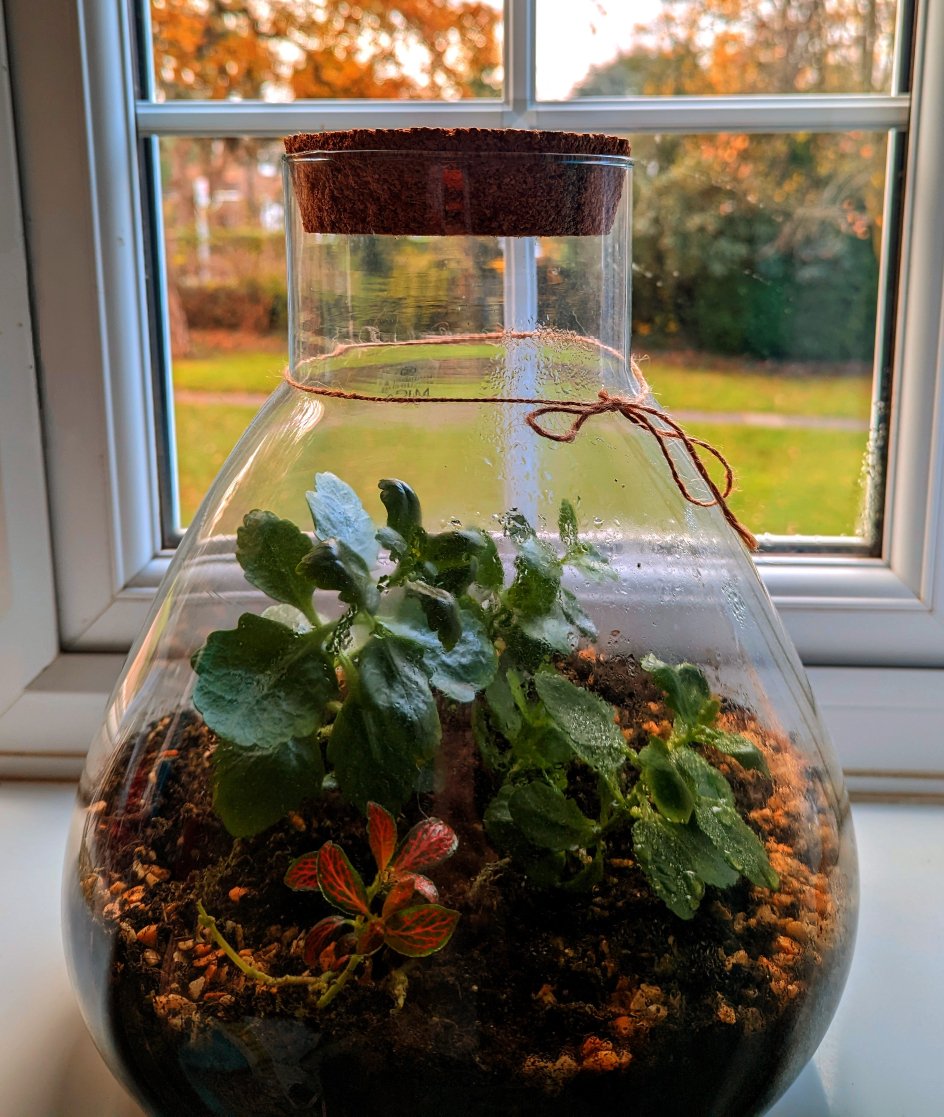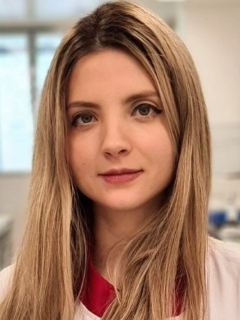
Image: Dr Vivian Dimou's terrarium representing tumours, their environment and their interactions. The bonsai tree is missing in the image. Credit: Dr Vivian Dimou.
The terrarium
The terrarium looked so beautiful as the morning’s sunlight entered the living room… The sealed glass jar was reflecting the light in the most elegant manner and the little bonsai tree stood proud in the middle of the moist, crumbly soil, surrounded by mini plants and small, colourful stones and pebbles… all so flawlessly balanced and in harmony with each other- a true treat for the eyes! A perfectly healthy, self-supplying, mini ecosystem!
As I was drinking my coffee and looking at the terrarium, I could not help but think that our bodies are also a big ecosystem, consisting of smaller, autonomous but at the same time closely communicating ecosystems. Every structure, every organ within us, forms a world of its own, a delicate network within a bigger one, which evolves over time and maintains its homeostasis via finely regulated processes.
But what happens when evolution decides to take another path and show us a different, tougher side?
Cancer and evolution are tightly bound to each other and, as organisms evolve, so does cancer, almost always finding a way to evade our body’s security checkpoints and continue to survive. Cancer-driving changes are often first subtle and might go unnoticed, maybe unable yet to affect the body’s generally healthy equilibrium, but along time they can silently accumulate and intensify, only to manifest when they have already established their own independent sphere of existence.
The upside down…
The terrarium had started looking different. First, just a small branch of the bonsai tree seemed a little yellowish but still everything looked harmonic and in unison in my little “ecosystem in a bottle”.
Time passed by and one rainy morning I suddenly felt alarmed. The terrarium looked familiar, yet odd. Like a different, gloomier version of its previous self. Many branches of the bonsai tree now were weak and a few of them had fallen on the soil, which by a closer look was dry and cracked. The pebbles and colourful stones were covered with moss. As a few more days went by, the little plants surrounding the bonsai tree shrunk and started to decompose. The terrarium now gave off an eerie feeling and was like a ghost of its old self... How could I have not realised the extent of the damage earlier?
The cancer ecosystem
Cancer symptoms often present once the disease has already evolved and spread enough to create a robust, independent tumour ecosystem. This is a particularly harsh truth for solid tumours.
Solid tumours can develop in all important organs of our body and create their own impenetrable cocoon that allows them to protect and sustain their life-threatening ecosystem. There are several layers to this cocoon to ensure that its “precious core”, the tumour cells, will remain safeguarded in the best way and for as long as possible.
The tumour cells themselves orchestrate the creation of their protective armour and put in place various strategies to achieve the maximum stability of their own world. They accumulate various mutations and epigenetic alterations offering them resistance to anti-cancer treatments, more longevity and unlimited proliferation. They can trigger angiogenesis, evade immune system recognition, and cell death. Furthermore, they have the power to invade neighbouring tissues.
The solid tumour core is supported by a strong vascular network formed by a mesh of capillaries and blood vessels promoting perpetual nutrient supply of the tumour mass and eventually, metastasis. The progressive build-up of a highly protective microenvironment is crucial for the creation of the “cocoon layers” around the tumour core. This microenvironment consists of extracellular matrix components -collagen, fibronectin and more- that form a dense fibrous web able to maintain the 3-D structure of cancerous masses.
Immunosuppressive cells localising in the tissue, such as fibroblasts and immune cells (Tregs, tumour-associated macrophages, myeloid-derived suppressor cells) become the best and most valuable neighbours and friends of the tumour cells. They have been recruited to support ongoing tumour growth, block the infiltration, or undermine the anti-tumoural function of other immune cells such as cytotoxic T, natural killer and dendritic cells.
All components of the cancerous ecosystem work in unison and continuously adapt to the evolutionary pressure, aiming to perpetually maintain this “upside down” world they have created; a darker, modified version of their previous selves. However, there is always light even at the darkest times.
The more we learn about the cancerous ecosystems through translational and evolutionary scientific research, the more easily we will be able to harness and “unseal” them, break them open and then fix them again. Novel anti-cancer targeted therapies and immunotherapies have already revolutionised the treatment of several solid tumours with -until recently- limited to no therapeutic options. Targeted therapies focus on eliminating tumour cells or components of their supportive microenvironment, whereas immunotherapies focus on boosting the function of immune cells able to elicit an anti-tumour response.
The number of patients eligible for novel combination therapies, is expected to soar in the following years, the more we “unlock” the secrets of the cancerous ecosystems. In the end, cancer could turn up to be just another chronic disease, managed through numerous different therapeutic approaches.
Unsealing the terrarium…
It took me a long time to understand what I had to do to save my terrarium. I had to unseal the glass jar and remove all the rotten parts. I bought a new type of soil, cut all the weak branches off my tree, replaced the small plants with new ones and removed the moss from the colourful pebbles.
In the end, my efforts paid off. The terrarium was healthy and beautiful again! Now, I could enjoy my coffee!
Imagine the bonsai tree as the tumour-affected tissue with the weak, yellowish branches representing the tumour cells. The soil represents the tumour microenvironment (blood vessels and extracellular matrix providing support), and the surrounding mini plants represent the cells that work in favour of the tumour. The beautiful pebbles and stones are the immune cells able to elicit anti-tumour responses, once freed of their immunosuppressive ties (the moss)!
This piece is shortlisted for the 2022 Mel Greaves Science Writing Prize.
Read more entries from the finalists
______________________________________________________________________
 Dr Vivian Dimou is from Halkida, Greece. She undertook her undergraduate degree in Molecular Biology & Genetics in Greece. She then moved to the UK, where she completed my PhD in autoimmunity and childhood lupus nephritis at the University of Liverpool. In 2018, she moved to London and undertook her first postdoc at St George’s University of London.
Dr Vivian Dimou is from Halkida, Greece. She undertook her undergraduate degree in Molecular Biology & Genetics in Greece. She then moved to the UK, where she completed my PhD in autoimmunity and childhood lupus nephritis at the University of Liverpool. In 2018, she moved to London and undertook her first postdoc at St George’s University of London.
Her work was focused on immuno-phenotyping blood samples from patients with acute coronary syndrome and atrial fibrillation, to investigate potential deregulations in the function of T cell populations.
Since March 2020, she has been a Postdoctoral Training Fellow in Dr Astero Klampatsa’s Thoracic Oncology Immunotherapy Group. The team is focused on studying mesothelioma, a rare and aggressive solid tumour primarily arising in the lung pleura, with limited therapeutic options so far. Her project is focused on exploring the mesothelioma immune landscape with the aim to identify novel immunotherapeutic targets.
comments powered by